Octoverse: The state of open source and rise of AI in 2023
In this year’s Octoverse report, we study how open source activity around AI, the cloud, and Git are changing the developer experience.

What does it mean for a new technology to go mainstream?
First released in 2005, Git was still a new open source version control system when we founded GitHub. Today, Git is a foundational element of the modern developer experience—93% of developers use it to build and deploy software everywhere1.
In 2023, GitHub data highlighted how another technology has quickly begun to reshape the developer experience: AI. This past year, more and more developers started working with AI, while also experimenting with building AI-powered applications. Git has fundamentally changed today’s developer experience, and now AI is setting the stage for what’s next in software development.
At GitHub, we know developers love to learn by doing and open source helps developers more rapidly adopt new technologies, integrate them into their workflows, and build what’s next. Open source also powers nearly every piece of modern software—including much of the digital economy. As we explore how technologies become mainstream, GitHub continues to play a pivotal role in bridging the gap between experimentation and the widespread adoption of open source technologies, which underpin the foundations of our software ecosystem.
In this year’s report, we’ll study how open source activity around AI, the cloud, and Git has changed the developer experience and is increasingly driving impact among developers and organizations alike.

We uncover three big trends:
- Developers are building with generative AI in big numbers. We’re seeing more developers experiment with foundation models from OpenAI and other AI players, with open source generative AI projects even entering the top 10 most popular open source projects by contributor count in 2023. With almost all developers (92%) using or experimenting with AI coding tools, we expect open source developers to drive the next wave of AI innovation on GitHub.2
- Developers are operating cloud-native applications at scale. We’re seeing an increase in declarative languages using Git-based infrastructure as code (IaC) workflows, greater standardization in cloud deployments, and a sharp increase in the rate at which developers were using Dockerfiles and containers, IaC, and other cloud-native technologies.
- 2023 saw the largest number of first-time open source contributors. We continue to see commercially backed open source projects capture the largest share of first-time contributors and overall contributions—but this year, we also saw generative AI projects enter the top 10 most popular projects for first-time contributors. We’re also seeing notable growth in private projects on GitHub, which increased 38% year over year and account for more than 80% of all activity on GitHub.
Kyle Daigle
Chief Operating Officer // GitHub
💡Oh, and if you’re a visual learner, we have you covered.👇
A global community of developers building on GitHub

Globally, developers are using GitHub to build software and collaborate in larger numbers than ever before—and that spans across public and private projects. This not only proves the foundational value of Git in today’s developer experience, but also shows the global community of developers using GitHub to build software.
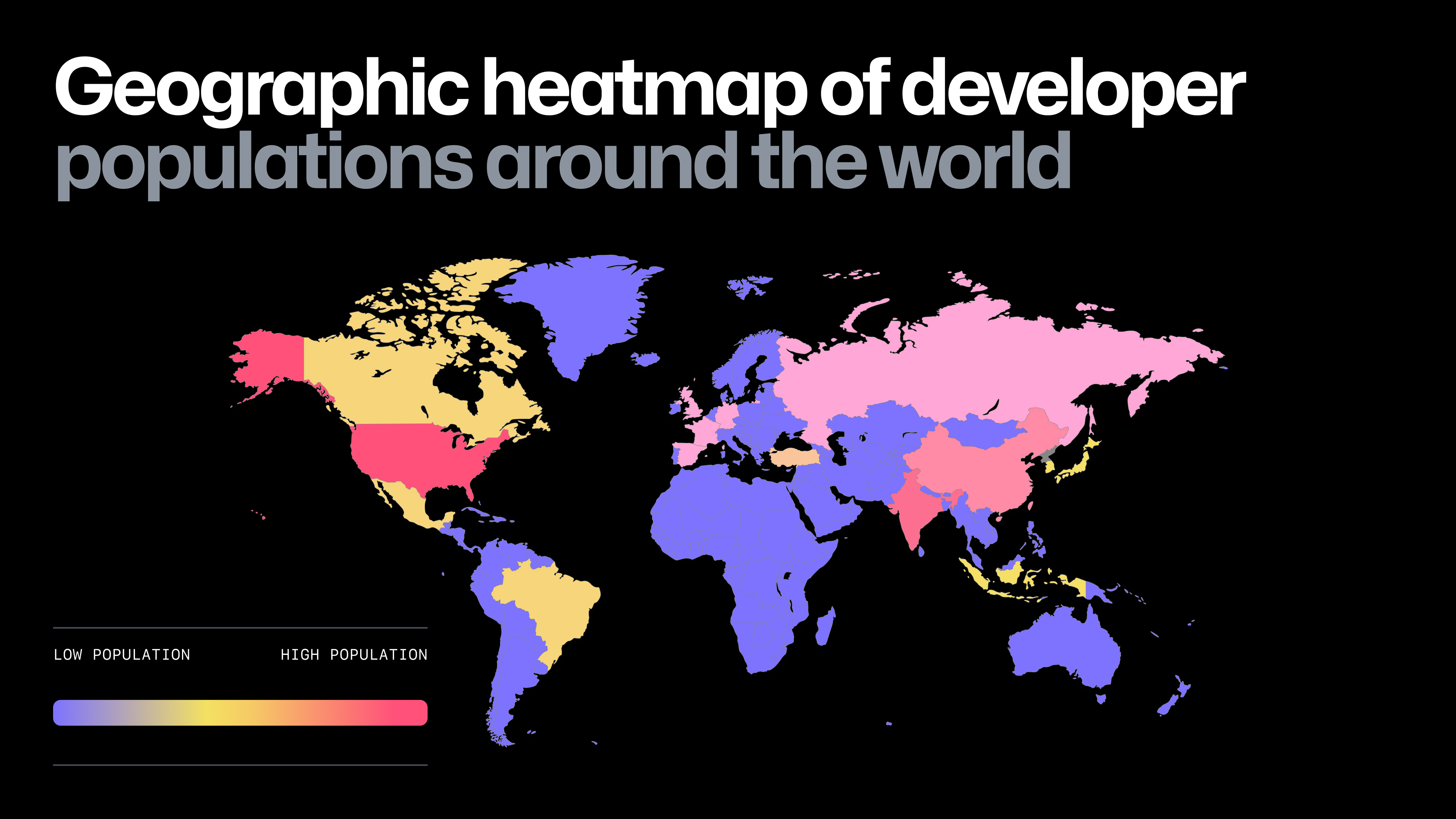
With 20.2 million developers and a 21% increase in developer growth over the past year, the U.S. continues to have the largest developer community globally. But since 2013, we’ve continued to see other communities account for more growth across the platform which we expect to continue. This worldwide distribution of developers on GitHub shows which regions have the most developers.
Developer communities in Asia Pacific, Africa, South America, and Europe are getting bigger year over year—with India, Brazil, and Japan among those leading the pack.

Projecting the top 10 developer communities over the next five years
To understand which developer communities are poised to grow the most over the next five years, we built projections based on current growth rates. Under this rubric, we anticipate that India will overtake the United States as the largest developer community on GitHub by 2027.

Fastest growing developer communities in Asia Pacific
We continue to see considerable growth in the Asia Pacific region driven by economic hubs in India, Japan, and Singapore.
| # of developers | YoY growth | |
|---|---|---|
| 01 Singapore | >1M developers | 39% |
| 02 India | >13.2M developers | 36% |
| 03 Hong Kong (SAR) | >1.6M developers | 35% |
| 04 Vietnam | >1.5M developers | 34% |
| 05 Indonesia | >2.9M developers | 31% |
| 06 Japan | >2.8M developers | 31% |
| 07 The Philippines | >1.3M developers | 31% |
| 08 Thailand | >857K developers | 25% |
| 09 South Korea | >1.9M developers | 22% |
| 10 Australia | >1.4M developers | 21% |
Table 1: Developer growth by total developers in 2023, % increase from 2022.
India’s developer community continues to see massive year-over-year growth.
In last year’s Octoverse, we predicted that India would overtake the United States in total developer population. That’s still on track to happen. India saw a 36% year-over-year increase in its developer population with 3.5 million new developers joining GitHub in 2023.
As a part of the UN-backed Digital Public Goods Alliance, India’s been building its digital public infrastructure with open materials—ranging from software code to AI models—to improve digital payments and ecommerce systems. Here’s a list of open source software (OSS) projects that Indian developers have built and are contributing to on GitHub.
Singapore saw the most growth in developer population this year in APAC, and ranks first globally with the highest ratio of developers to overall population.
The National University of Singapore’s School of Computing incorporates GitHub into its curriculum, and high growth may also be attributable to the country’s regulatory significance in Southeast Asia.
We’re also likely to see continued developer growth in Japan over the next year as a result of its investments in technology and startups.
Fastest growing developer communities in Africa
With the fastest growing population in the world and an increasing pool of developers, African regions have been identified as promising hubs for technology companies. (For example, in Kenya, programming is mandatory to teach in primary and secondary school.)
| # of developers | YoY growth | |
|---|---|---|
| 01 Nigeria | >868K developers | 45% |
| 02 Ghana | >152K developers | 41% |
| 03 Kenya | >296K developers | 41% |
| 04 Morocco | >446K developers | 35% |
| 05 Ethiopia | >94K developers | 32% |
| 06 South Africa | >539K developers | 30% |
Table 2: Developer growth by total developers in 2023, % increase from 2022.
Nigeria is a hot spot for OSS adoption and technological investments, and its 45% year-over-year growth rate—which is the largest worldwide increase—reflects this. There’s also a collection of at least 200 projects on GitHub made by Nigerian developers, which can be found under the “Made in Africa” collection.
Fastest growing developer communities in South America
Developer growth rates in South America are on par with some of the fastest-growing developer communities in Asia Pacific and Africa.
| # of developers | YoY growth | |
|---|---|---|
| 01 Argentina | >925K developers | 33% |
| 02 Bolivia | >105K developers | 33% |
| 03 Colombia | >872K developers | 31% |
| 04 Brazil | >4.3M developers | 30% |
| 05 Chile | >437K developers | 26% |
Table 3: Developer growth by total developers in 2023, % increase from 2022.
In 2023, Brazil’s developer population was the largest in this region and continues to grow by double-digits with a 30% year-over-year increase. This follows continued investment by private and public organizations in Brazil. Check out the list of OSS projects that Brazilian developers made and are contributing to on GitHub.
We’re also seeing continued growth in Argentina and Colombia, which have emerged over the last few years as popular investment targets for organizations.
Fastest growing developer communities in Europe
Communities throughout Europe continue to see increases in their overall developer populations, but their development now more closely mirrors the United States in aggregate as communities in South America, Africa, and the Asia Pacific outpace them in growth.
| # of developers | YoY growth | |
|---|---|---|
| 01 Spain | >1.5M developers | 25% |
| 02 Portugal | >410K developers | 24% |
| 03 Poland | >1.2M developers | 24% |
| 04 Germany | >2.9M developers | 22% |
| 05 Italy | >1.1M developers | 22% |
| 06 France | >2.3M developers | 22% |
| 07 United Kingdom | >3.4M developers | 21% |
Table 4: Developer growth by total developers in 2023, % increase from 2022.
Notably, the growth in France follows its government push to attract more tech startups. We’re also seeing an uptick in growth in Spain and Italy, which speaks to efforts in these two regions to bolster their domestic technology markets.
The explosive growth of generative AI in 2023
While generative AI made a splash in news headlines in 2023, it’s not entirely new to developers on GitHub. In fact, we’ve seen several generative AI projects emerge on GitHub over the past several years—and plenty of other AI-focused projects, too.
But GitHub data in 2023 reflects how these AI projects have progressed from more specialist-oriented work and research to more mainstream adoption with developers increasingly using pre-trained models and APIs to build generative AI-powered applications.
Just halfway through this past year, we saw more than twice the number of generative AI projects in 2023 as in all of 2022. And we know this is just the tip of the iceberg.
As more developers experiment with these new technologies, we expect them to drive AI innovation in software development and continue to bring the technology’s fast-evolving capabilities into the mainstream.

Developers are increasingly experimenting with AI models. Where in years past we saw developers building projects with machine learning libraries like tensorflow/tensorflow, pytorch/pytorch, we now see far more developers experimenting with AI models and LLMs such as the ChatGPT API.
Stay smart: we anticipate businesses and organizations to also leverage pre-trained AI models—especially as more and more developers become familiar with building with them.
Open source AI innovation is diverse and the top AI projects are owned by individual developers. Analyzing the top 20 open source generative AI projects on GitHub, some of the top projects are owned by individuals. That suggests that open source projects on GitHub continue to drive innovation and show us all what’s next in the industry, with the community building around the most exciting advancements.
Generative AI is driving a significant and global spike in individual contributors to generative AI projects with 148% year-over-year growth—and a 248% year-over-year increase in the total number of generative AI projects, too. Notably, the United States, India, and Japan are leading the way among developer communities with other regions, including Hong Kong (SAR), the United Kingdom, and Brazil following.

💡 The massive uptick in the number of developers learning about generative AI will impact businesses. As more and more developers gain familiarity with building generative AI-powered applications, we expect a growing talent pool to bolster businesses that seek to develop their own AI-powered products and services.
The bottom line: over the past year, we have seen an exponential growth in applications being built on top of foundation models, like ChatGPT, as developers use these LLMs to develop user-facing tools, such as APIs, bots, assistants, mobile applications, and plugins. Developers globally are helping to lay the groundwork for mainstream adoption, and experimentation is helping to build a talent pool for organizations.
The most popular programming languages

Since we saw a massive growth in cloud-native development in 2019, IaC has continued to grow in open source. In 2023, Shell and Hashicorp Configuration Language (HCL) once again emerged as top languages across open source projects, indicating that operations and IaC work are gaining prominence in the open source space.
- HCL adoption registered 36% year-over-year growth, which shows that developers are making use of infrastructure for their applications.
- The increase in HCL suggests developers are increasingly using declarative languages to dictate how they’re leveraging cloud deployments.
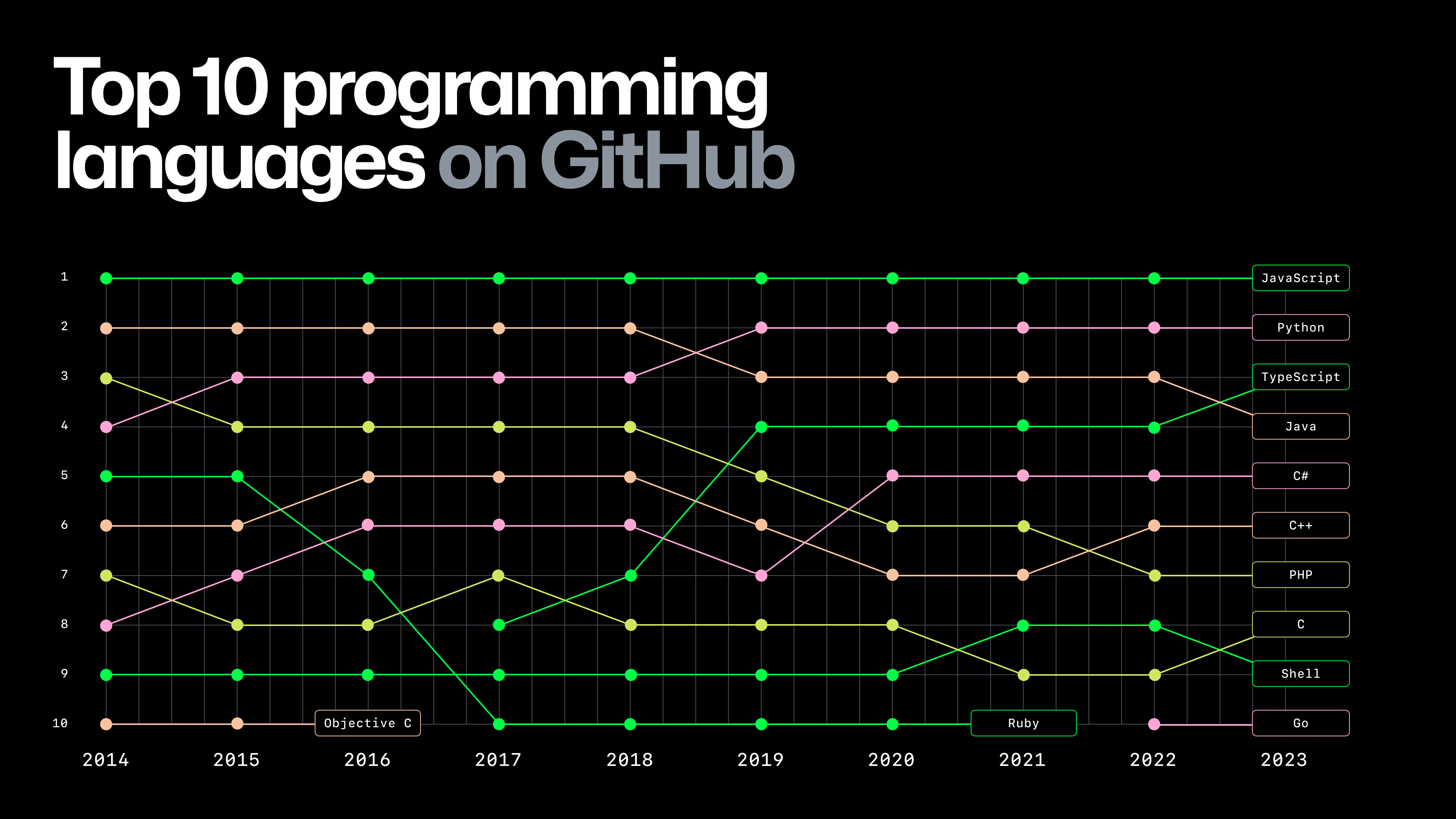
JavaScript has once again taken the crown for the #1 most popular language, and we continue to see familiar languages, such as Python and Java, remain in the top five languages year over year.
TypeScript rises in popularity. This year, TypeScript overtook Java for the first time as the third most popular language across OSS projects on GitHub with 37% growth of its user base. A language, type checker, compiler, and language service all in one, TypeScript was launched in 2012 and marked the dawn of gradual types, which allow developers to adopt varying levels of static and dynamic typing in their code. Learn more about Typescript >

There has been a notable increase in popular languages and frameworks for data analytics and operations. Venerable languages, such as T-SQL and TeX, grew in 2023, which highlights how data scientists, mathematicians, and analysts are increasingly engaging with open source platforms and tooling.
The bottom line: Programming languages aren’t just confined to the realm of traditional software development anymore.
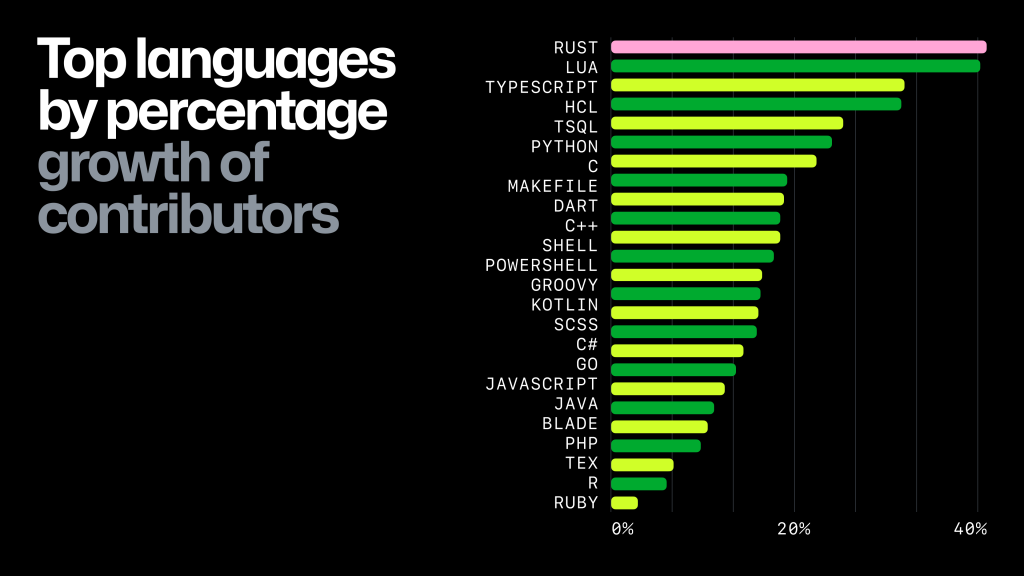
We see remarkable parity with the most popular languages used in projects created in 2023 when compared to the overall most popular languages used across GitHub. Some notable outliers include Kotlin, Rust, Go, and Lua, which have seen larger growth across newer projects on GitHub.
Both Rust and Lua are notable for their memory safety and efficiency—and both can be used for systems and embedded systems programming, which can be attributed to their growth. And the recent growth of Go is driven by cloud-native projects, such as Kubernetes and Prometheus.
Developer activity as a bellwether of new tech adoption
In early 2023, we celebrated a milestone of more than 100 million developers using GitHub—and since last year we’ve seen a nearly 26% increase in all global developer accounts on GitHub. More developers than ever collaborate across time zones and build software. Developer activity, in both private and public repositories, underscores what technologies are being broadly adopted—and what technologies are poised for wider adoption.

Developers are automating more of their workflows. Over the past year, developers used 169% more GitHub Actions minutes to automate tasks in public projects, develop CI/CD pipelines, and more.
- On average, developers used more than 20 million GitHub Actions minutes a day in public projects. And the community keeps growing with the number of GitHub Actions in the GitHub Marketplace passing the 20,000 mark in 2023.
- This underscores growing awareness across open source communities around automation for CI/CD and community management.
More than 80% of GitHub contributions are made to private repositories. That’s more than 4.2 billion contributions to private projects and more than 310 million to public and open source projects. These numbers show the sheer scale of activity happening across public, open source, and private repositories through free, Team, and GitHub Enterprise accounts. The abundance of private activity suggests the value of innersource and how Git-based collaboration doesn’t benefit the quality of just open source but also proprietary code.
In fact, all developers in a recent GitHub-sponsored survey said their companies have adopted some innersource practices at minimum, and over half said there’s an active innersource culture in their organization.
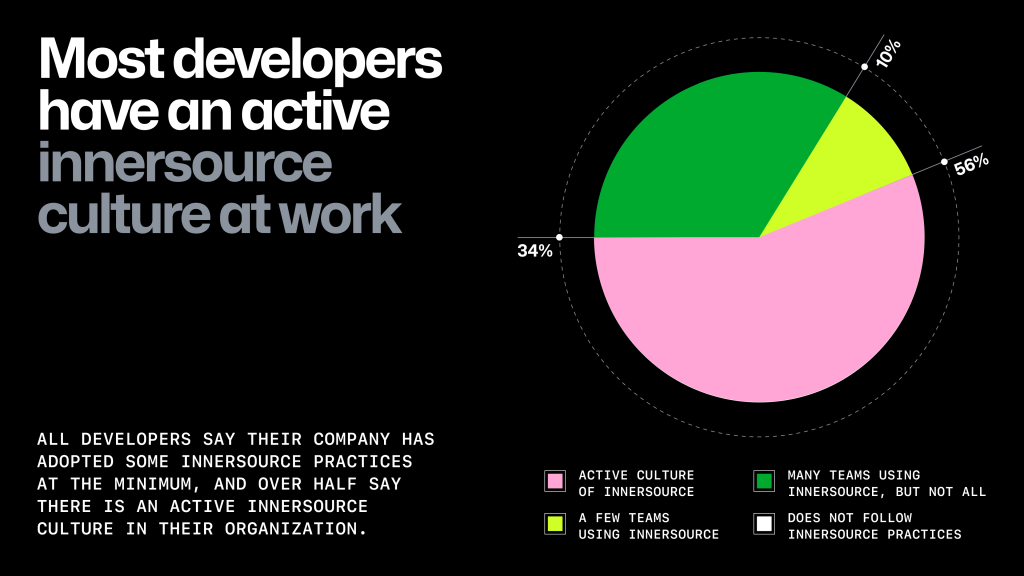
GitHub is where developers are operating and scaling cloud-native applications. In 2023, 4.3 million public and private repositories used Dockerfiles—and more than 1 million public repositories used Dockerfiles for creating containers. This follows the increased use we’ve seen in Terraform and other cloud-native technologies over the past few years. The increased adoption of IaC practices also suggests developers are bringing more standardization to cloud deployments.

Generative AI makes its way into GitHub Actions. The early adoption and collaborative power of AI among the developer community is apparent in the 300+ AI-powered GitHub Actions and 30+ GPT-powered GitHub Actions in the GitHub Marketplace. Developers not only continue to experiment with AI, but are also bringing it to more parts of the developer experience and their workflows through the GitHub Marketplace.
The bottom line: developers experiment with new technologies and share their learnings across public and private repositories. This interdependent work has surfaced the value of containerization, automation, and CI/CD to package and ship code across open source communities and companies alike.
The state of security in open source
This year, we’re seeing developers, OSS communities, and companies alike respond faster to security events with automated alerts, tooling, and proactive security measures—which is helping developers get better security outcomes, faster. We’re also seeing responsible AI tooling and research being shared on GitHub.
More developers are using automation to secure dependencies. In 2023, open source developers merged 60% more automated Dependabot pull requests for vulnerable packages than in 2022—which underscores the shared community’s dedication to open source and security. Developers across open source communities are fixing more vulnerable packages and addressing more vulnerabilities in their code thanks to free tools on GitHub, such as Dependabot, code scanning, and secret scanning.
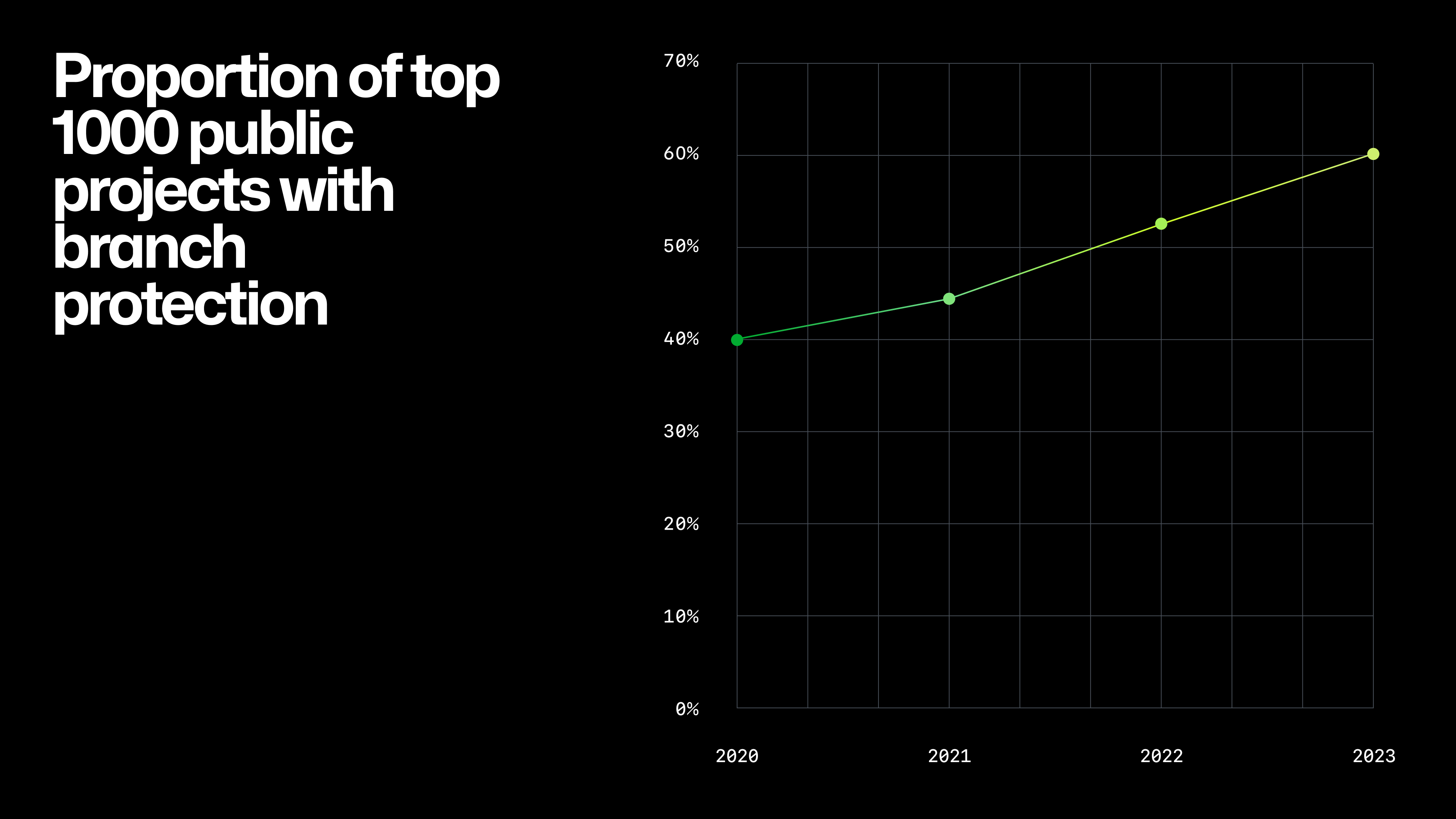
More open source maintainers are protecting their branches. Protected branches give maintainers more ways to ensure the security of their projects and we’ve seen more than 60% of the most popular open source projects using them. Managing these rules at scale should get even easier since we launched repository rules on GitHub in GA earlier this year.
Developers are sharing responsible AI tooling on GitHub. In the age of experimental generative AI, we’re seeing a development trend in AI trust and safety tooling. Developers are creating and sharing tools around responsible AI, fairness in AI, responsible machine learning, and ethical AI.
The Center for Security and Emerging Technology at Georgetown University is also identifying which countries and institutions are the top producers of trustworthy AI research and sharing its research code on GitHub.
The bottom line: to help OSS communities and projects stay more secure, we’ve invested in making Dependabot, protected branches, CodeQL, and secret scanning available for free to public projects. New adoption metrics in 2023 show how these investments are succeeding in helping more open source projects improve their overall security. We’re also seeing interest in creating and sharing responsible AI tools among software developers and institutional researchers.
The state of open source
In 2023, developers made 301 million total contributions to open source projects across GitHub that ranged from popular projects like Mastodon to generative AI projects like Stable Diffusion, and LangChain.
Commercially backed projects continued to attract some of the most open source contributions—but 2023 was the first year that generative AI projects also entered the top 10 most popular projects across GitHub. Speaking of generative AI, almost a third of open source projects with at least one star have a maintainer who is using GitHub Copilot.

Commercially backed projects continue to lead. In 2023, the largest projects by the total number of contributors were overwhelmingly commercially backed. This is a continued trend from last year, with microsoft/vscode, flutter/flutter, and vercel/next.js making our top 10 list again in 2023.
Generative AI grows fast in open source and public projects. In 2023, we saw generative AI-based OSS projects, like langchain-ai/langchain and AUTOMATIC1111/stable-diffusion-webui, rise to the top projects by contributor count on GitHub. More developers are building LLM applications with pre-trained AI models and customizing AI apps to user needs.
Open source maintainers are adopting generative AI. Almost a third of open source projects with at least one star have a maintainer who is using GitHub Copilot. This follows our program to offer GitHub Copilot for free to open source maintainers and shows the growing adoption of generative AI in open source.
Developers see benefits to combining packages and containerization. As we noted earlier, 4.3 million repositories used Docker in 2023. On the other side of the coin, Linux distribution NixOS/nixpkgs has been on the top list of open source projects by contributor for the last two years.
First-time contributors continue to favor commercially backed projects. Last year, we found that the power of brand recognition around popular, commercially backed projects drew more first-time contributors than other projects. This continued in 2023 with some of the most popular open source projects among first-time contributors backed by Microsoft, Google, Meta, and Vercel.

But community-driven open source projects ranging from home-assistant/core to AUTOMATIC1111/stable-diffusion-webui, langchain-ai/langchain, and Significant-Gravitas/Auto-GPT also saw a surge in activity from first-time contributors. This suggests that open experimentation with foundation models increases the accessibility of generative AI, opening the door to new innovations and more collaboration.
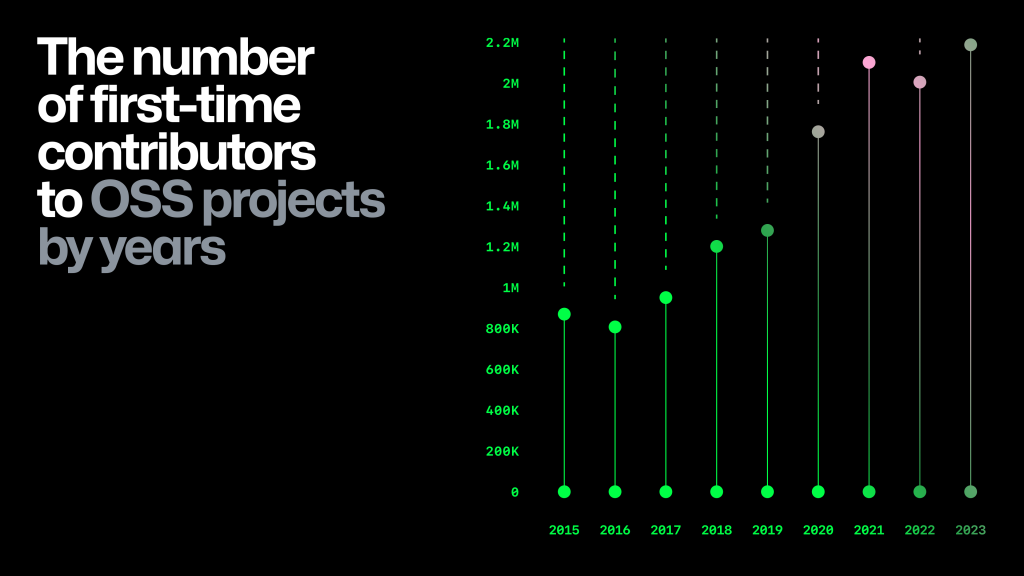
2023 saw the largest number of first time contributors contributing to open source projects. New developers became involved with the open source community through programs like freeCodeCamp, First Contributions, and GitHub Education. We also saw a large number of developers taking part in online, open sourced education projects from the likes of Google and IBM.
The bottom line: developers are contributing to open source generative AI projects, open source maintainers are adopting generative AI coding tools, and companies continue to rely on open source software. These are all indications that developers who learn in the open and share their experiments with new technologies lift an entire global network of developers—whether they’re working in public or private repositories.
Take this with you
Just as Git has become foundational to today’s developer experience, we’re now seeing evidence of the mainstream emergence of AI. In the past year alone, a staggering 92% of developers have reported using AI-based coding tools, both inside and outside of work. This past year has also seen an explosive surge in AI experimentation across various open source projects hosted on GitHub.
We leave you with three takeaways:
- GitHub is the developer platform for generative AI. Generative AI evolved from a specialist field into mainstream technology in 2023—and an explosion of activity in open source reflects that. As more developers build and experiment with generative AI, they’re using GitHub to collaborate and collectively learn.
- Developers are operating cloud-native applications at scale on GitHub. In 2019, we started to see a big jump in the number of developers using container-based technologies in open source—and the rate at which developers are increasingly using Git-based IaC workflows, container orchestration, and other cloud-native technologies sharply increased in 2023. This enormous amount of activity shows that developers are using GitHub to standardize how they deploy software to the cloud.
- GitHub is where open source communities, developers, and companies are building software. In 2023, we saw a 38% increase in the number of private repositories—which account for more than 81% of all activity on GitHub. But we are seeing continued growth in the open source communities who are using GitHub to build what’s next and push the industry forward. With the data showing the increase in new open source developers and the rapid pace of innovation that is possible in open communities, it’s clear that open source has never been stronger.
Methodology
This report draws on anonymized user and product data taken from GitHub from October 1, 2022 through September 30, 2023. We define AI projects on GitHub by 683 repository topic terms, which you can learn more about in research we conducted in 2023 (page 25 to be exact). We also evaluate open source projects by a metric we call “Mona Rank,” which is a rank-based analysis of the community size and popularity of projects.
More data is publicly available on the GitHub Innovation Graph—a research tool GitHub offers for organizations and individuals curious about the state of software development across GitHub.
For a complete methodology, please contact press@github.com.
Glossary
- 2023: a year in this report is the last 365 days from the last Octoverse release and ranges from 10/1/2022 to 9/30/2023.
- Developers: developers are individual, not-spammy user accounts on GitHub.
- Public projects: any project on GitHub that is publicly available for others to contribute to, fork, clone, or engage with.
- Open Source Projects and Communities: open source projects are public repositories with an open source license.
- Location: geographic information is based on the last known network location of individual users and organization profiles. We only study anonymized and aggregated location data, and never look at location data beyond the geographic region and country.
- Organizations: organization accounts represent groups of people on GitHub that can be paid or free and big or small.
- Projects and Repositories: we use repositories and projects interchangeably, but recognize that larger projects can sometimes span multiple repositories.
Tags:
Related posts

How researchers are using GitHub Innovation Graph data to estimate the impact of ChatGPT
An interview with economic researchers who are applying causal inference techniques to analyze the effect of generative AI tools on software development activity.

GitHub Availability Report: June 2024
In June, we experienced two incidents that resulted in degraded performance across GitHub services.

Advancing responsible practices for open source AI
Outcomes from the Partnership on AI and GitHub workshop.







